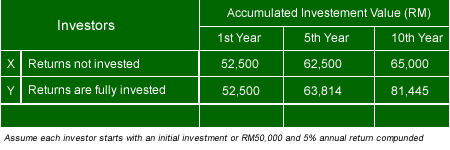Re-investing your fund returns can help your wealth grow over the long time period. Investors need to know the advantages of re-investing the fund returns as this is a simple strategy which takes advantage of the power of compounding.
Reinvestment based on the principle of compounding is a powerful strategy as the annual investment returns are reinvested back into the principle to generate additional returns in future. Even the fixed deposit savers who lock in their money normally choose for monthly compound interest to benefit from the compounding effect. For those unit trust investors who automatically reinvest their distributions back into the fund, their investment can be grown at the fund’s compounded rate of return over the years.
However the compounding effect requires time. The longer the time over we reinvest our returns, the greater rewards we will gain as we allow our investments to grow over the time.

As we can see the table above, Investor X and Investor Y both invest an initial sum of RM50,000 in the same year which yields an annual return of 5%. Investor X does not reinvest his returns but Investor Y fully reinvests the returns. At the end of first year, both investors have accumulated same amount of wealth of RM52,500. However, in the 5th year , Investor X’s investment amounts to RM62,500 whereas Investor Y investment is 2.1% higher than Investor X at RM63,814.
Hence, we can see that the value of our investments would be limited if we chose not to reinvest our returns. Besides, we can see that the disparity between ten final wealth accumulated between Investor X and Y widens exponentially over time.
Reinvestment based on the power of compounding has been proven an effective strategy for long term investors. By making small initial investment amounts early in life, our savings can grow exponentially over the years.
